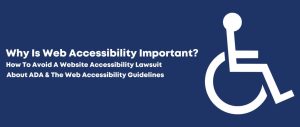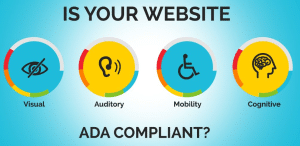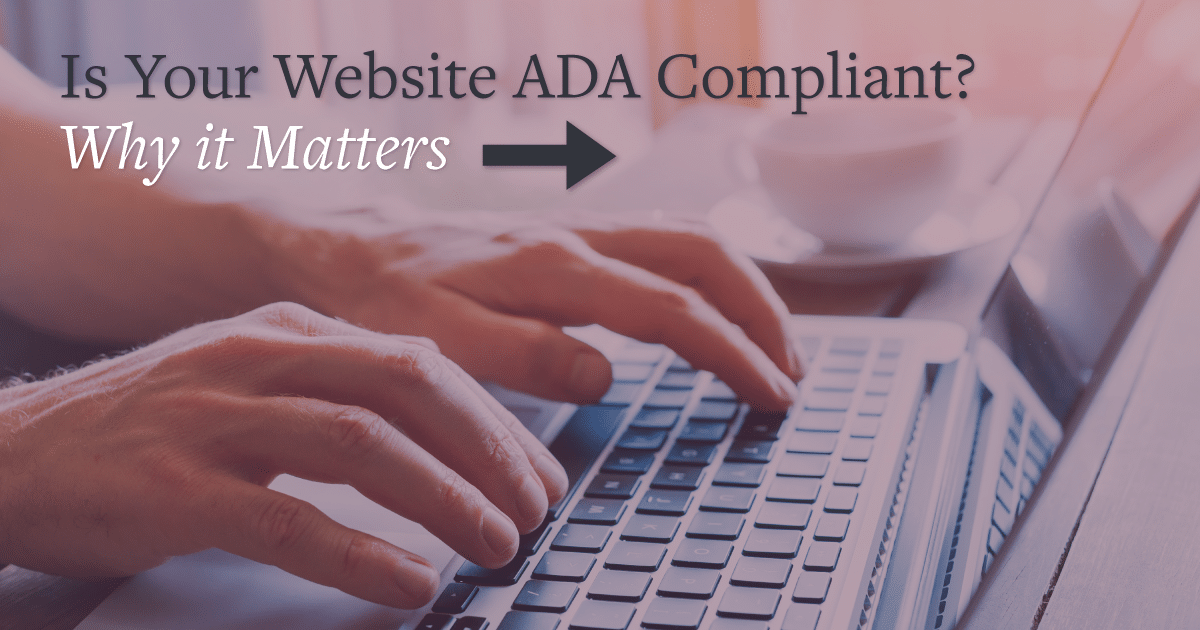Is Your Website ADA-Compliant? Here’s Why Accessibility Matters
In today’s digital-first world, your website isn’t just a digital storefront — it’s your handshake, your salesperson, and your brand ambassador. But here’s the big question: Is your website ADA-compliant? If you’re unsure, you’re not alone — and you’re definitely not too late to fix it.
ADA compliance isn’t just about avoiding lawsuits. It’s about creating an inclusive, user-friendly experience for everyone — including people with disabilities. In this post, we’ll break down what ADA compliance means for websites, why it matters, and give you a clear, step-by-step guide to get your site up to standard.
🌐 What Does ADA Compliance Mean for Websites?
The Americans with Disabilities Act (ADA) was enacted in 1990 to prevent discrimination against people with disabilities in all areas of public life — including the digital space. While the original law didn’t explicitly mention websites, courts have increasingly ruled that websites must also be accessible.
To help guide digital accessibility, many developers use the Web Content Accessibility Guidelines (WCAG) — a globally recognized standard that outlines how to make web content more accessible to people with various disabilities, including:
-
Visual impairments
-
Hearing loss
-
Cognitive limitations
-
Motor difficulties
In short, ADA compliance means ensuring your website can be used by people with disabilities, without barriers.
🤔 Why Accessibility Matters (Even If You’re a Small Business)
Let’s get one thing straight — accessibility is not just a “big business” problem. Whether you’re a local shop owner, a freelancer, or running a growing e-commerce store, making your website accessible benefits everyone. Here’s why:
✅ 1. Legal Protection
Non-compliance can lead to lawsuits. In fact, ADA website accessibility lawsuits increased significantly in recent years, targeting both large and small businesses. Ensuring compliance protects you from legal risk.
✅ 2. Improved User Experience
Accessible websites are easier for all users to navigate. Features like clear contrast, readable fonts, and keyboard navigation benefit everyone — not just those with disabilities.
✅ 3. Larger Audience Reach
Approximately 1 in 4 adults in the U.S. lives with a disability. By making your site accessible, you’re opening your doors to millions of potential visitors and customers.
✅ 4. SEO Benefits
Many ADA best practices align closely with SEO best practices — think faster page load times, video transcripts, proper heading structures, and alt text for images. Accessibility can support your search rankings.
🛠️ Step-by-Step Guide to Make Your Website ADA-Compliant
Creating an accessible website doesn’t have to be overwhelming. Here’s a step-by-step guide to help you make meaningful progress.
Step 1: Familiarize Yourself with WCAG Guidelines
Start by understanding WCAG 2.1, the most current version at the time of writing. It’s organized around four key principles — your website should be:
-
Perceivable: Users must be able to perceive the content.
-
Operable: Interface components must be usable via different means.
-
Understandable: Content and operation must be clear and predictable.
-
Robust: Content must work across different devices and assistive technologies.
You don’t need to memorize all 50+ success criteria — focus on key areas that impact users most.
Step 2: Use an Accessibility Audit Tool
Run your website through a free accessibility scanner like:
-
WAVE (Web Accessibility Evaluation Tool)
-
axe DevTools
-
Lighthouse (built into Chrome DevTools)
These tools identify common issues like:
-
Missing image alt text
-
Low contrast ratios
-
Improper heading structures
-
Keyboard navigation issues
Step 3: Fix the Most Common Issues
Here are some quick wins that instantly improve accessibility:
✅ Add Alt Text to Images
Every image should have a descriptive alt attribute, especially if it conveys essential information.
✅ Ensure Proper Color Contrast
Text should have enough contrast against its background. WCAG recommends a contrast ratio of at least 4.5:1 for normal text.

✅ Use Semantic HTML
Use headings (<h1> through <h6>), lists (<ul>, <ol>), and buttons correctly so screen readers can interpret your page accurately.
✅ Make Your Site Keyboard-Friendly
Ensure users can navigate your site using the keyboard only (e.g., using Tab to move between links and buttons).
✅ Provide Video Captions and Transcripts
Include closed captions for all video content and transcripts for audio files or podcasts.
✅ Label Form Fields Clearly
Every form input should have a descriptive label, and error messages should be easy to understand and fix.
Step 4: Add ARIA Landmarks (When Necessary)
ARIA (Accessible Rich Internet Applications) attributes can help screen readers understand dynamic or complex content — but use them wisely. Improper ARIA can do more harm than good, so stick to native HTML when possible.
Step 5: Test with Real Users or Screen Readers
If you can, involve users with disabilities to test your site. Alternatively, try navigating your site with:
-
A screen reader (like NVDA or VoiceOver)
-
Keyboard-only controls
-
Reduced motion or dark mode settings
This helps identify real-world usability issues that automated tools might miss.
Step 6: Keep Accessibility in Your Ongoing Workflow
Accessibility isn’t a one-time fix — it’s an ongoing practice. Make it part of your content updates, design reviews, and development sprints.
❓ Frequently Asked Questions (FAQs)
Q1: Is ADA compliance legally required for all websites?
Technically, the ADA doesn’t mention websites explicitly, but courts have interpreted it to apply to online content — especially for businesses considered “places of public accommodation.” If you operate in the U.S. and serve the public, your site should be accessible.
Q2: What happens if my website isn’t ADA-compliant?
You could face legal complaints, including fines and lawsuits. Even if you’re a small business, there’s growing legal pressure to comply — especially if someone files an accessibility complaint.
Q3: How much does it cost to make a website ADA-compliant?
Costs vary. Basic fixes (like adding alt text or fixing contrast) can be done for free if you manage your own site. Larger audits or custom development may range from a few hundred to several thousand dollars, depending on complexity.

Q4: Can I use a plugin or widget to make my site accessible?
Accessibility overlays and widgets promise quick fixes, but many experts and advocacy groups argue they don’t provide full compliance. They can also cause conflicts with assistive technologies. It’s best to address accessibility directly in your site’s code and content.
Q5: What tools can help me maintain compliance over time?
Here are some reliable tools:
-
Deque’s axe tools (for developers)
-
Siteimprove or Monsido (for ongoing monitoring)
-
Google Lighthouse (basic automated testing)
-
NVDA or JAWS (screen reader testing)
💡 Final Thoughts: Accessibility Is Everyone’s Business
So — is your website ADA-compliant? If you’re not sure, the best time to start improving accessibility is right now. It’s not just about ticking a box or avoiding fines — it’s about respecting and including all of your users.
Making your site more accessible improves usability, broadens your audience, supports your SEO, and — most importantly — builds a better web for everyone.
Start small. Start today. Accessibility is progress, not perfection.
Need help improving your site’s accessibility? Consider working with a certified accessibility consultant or a developer experienced with WCAG standards. Investing in inclusion is not just the right thing to do — it’s smart business.





